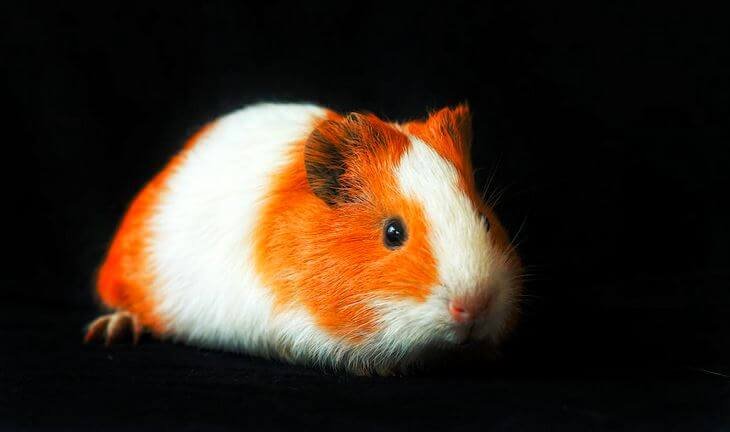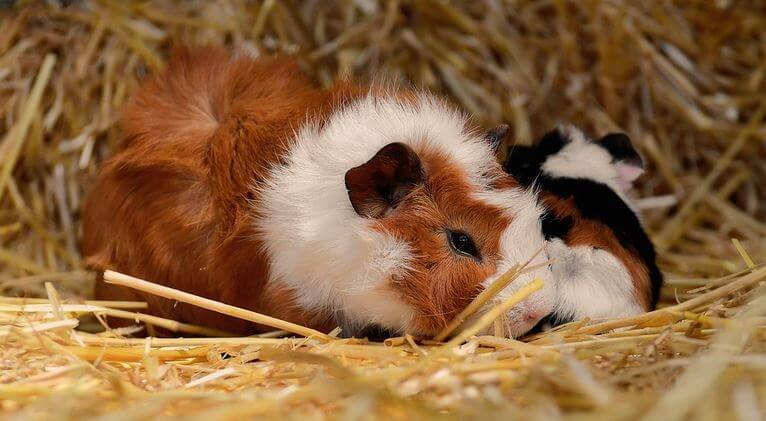On average, at least 20 percent of guinea pigs die while giving birth. Whether the death is a result of negligence or natural factors, this guide will help you know how to tell how far along your guinea pig is into pregnancy. You’ll also be able to leverage the information shared here to help your expectant furry friend live a safe life throughout her pregnancy.
You can tell how far your guinea pig is into pregnancy by observing her physical appearance. When stretched out, she displays straight sides in early pregnancy. By mid-pregnancy, the sides bulges a little bit and swells more in later pregnancy stages, accompanied with wide hips and increased weight.
In this article, I’ll discuss guinea pig pregnancy development stages. I’ll also discuss how to help your guinea pig during pregnancy. Keep reading!
Guinea Pig Pregnancy Development Stages

When looking to know how to tell how far along your guinea pig is into pregnancy, the first place to start is the piggy’s pregnancy development stages. These stages are accompanied by vital signs that illustrate a piggy’s pregnancy progress.
The signs that come along with the guinea pig’s pregnancy development stages will help you prepare for the forthcoming delivery.
Even more importantly, you know when and what to do at each developmental stage.
The table below is a quick guide to guinea pig pregnancy development stages:
| Pregnancy Stage | What to Look For |
| Week 1-3 | Watch out for straight sides when the guinea pig is stretched out. |
| Week 4-6 | Ultrasound screening can reveal the presence of fetuses. The sides are significantly swollen due to the much-grown babies. Check for a tennis ball-like appearance on the guinea pig’s sides. |
| Week 7-9 | Hips and rear limbs widen significantly in preparation for birth. You can now see and even feel the babies moving in the guinea pig’s belly. The belly is basically distended. Difficulty in movement comes about due to increased weight. |
As the guinea pig goes through one stage of pregnancy to another, the presence of babies in her belly becomes apparent. However, note that the above signs may not prove pregnancy.
They may vary from one animal to another. Therefore, ensure to visit your veterinarian for a thorough physical examination for a more precise assessment.
An experienced vet will tell you which pregnancy stage your guinea pig is in. Plus, they’ll advise how you need to care for the pregnant guinea pig until she gives birth.
Also Read: How to Help a Dying Guinea Pig in 7 Easy Ways
How Far Along Is My Guinea Pig If I Can Feel The Babies?
If you can feel the babies moving or kicking inside your guinea pig, know she is in the later stages of pregnancy. Soon, the guinea pig will give birth.
According to RSPCA Australia, guinea pig pregnancies lasts between 59 and 72 days, averaging 65 days.
Feeling the babies moving in the guinea pig’s belly tells you the piggy is in the final weeks of gestation. This is usually around week eight of the gestation period. You can distinguish the babies’ different parts as you feel them.
Everything is apparently fine at this stage; therefore, as a pet parent, you should be excited about the forthcoming babies.
Once you visit the vet for consultations and confirmation of the pregnancy stage, they may perform physical tests like:
- Ultrasound examination
- X-ray
- Gentle palpation
Accordingly, your vet should advise you on how to prepare for the birth process. Remember that 20 percent of pregnant guinea pigs die due to pregnancy complications. Therefore, you need the skills to care for your piggy during the pregnancy until when she gives birth and beyond.
Find Out: Guinea Pig Death Process: 5 Transitioning Stages
What to Feed a Pregnant Guinea Pig

You should feed a pregnant guinea pig a properly balanced diet for a smooth pregnancy and delivery. The best pregnant guinea pig diet should consist of the following:
- Grass or hay
- Green leafy vegetables (ensure fresh vegetables are provided regularly)
- Vitamin C-rich foods like kiwi fruit (should be in moderate amounts)
- Commercial pellets in small quantities
- Lucerne hay as a supplement for calcium and protein
Besides the food, your guinea pig should have access to clean, fresh water. This means changing the water in the bowl at least 2-3 times a day.
Avoid foods that could cause harm to your pregnant guinea pig. Some of the harmful foods include:
- Chocolate
- Caffeine
- Dairy products
- Onions
- Garlic
- High-sugar foods and fatty foods
Such foods puts the health of your guinea pig and her babies at great risk. For example, high-calorie foods lead to obesity that can kill your beloved piggy if not corrected in time.
The normal weight of a pregnant guinea pig should be about 35 ounces when carrying the litter for the first time. This weight can increase in subsequent pregnancies.
In that regard, daily tracking of your guinea pig’s weight is vital. While a pregnant piggy automatically gains extra pounds (around 10 pounds/4.54 kg) due to the growing babies in her belly, the weight gain shouldn’t be caused by poor feeding habits and diet.
How Do Guinea Pigs Act Before Giving Birth?
Before giving birth, a guinea pig can change temperament and become less active. The behavior change is definitely a short-lived affair that lasts as long as the labor.
Here are general behaviors and physical changes that indicate a guinea pig approaching the labor period.
- Nesting Behavior: When a guinea pig approaches labor, you may notice her rearranging the bedding using available materials in the cage. She wants the delivery to be as safe and comfortable as possible. Guinea pigs do not build nests but may simply rearrange the materials.
- Restlessness: You will notice restlessness in a guinea pig almost due for the birthing process. She appears unsettled, uncomfortable, and also anxious.
- Lethargy/Decreased activity: During the very final hours of labor, usually 24 to 48 hours, the guinea pig becomes extremely less active. She prefers staying in her nest and grooming herself rather than moving around.
- Increased urination frequency: Frequent urination is more apparent in guinea pigs almost giving birth.
That being said, these behaviors vary between different guinea pigs. But if you see your guinea pig displaying most of them, ensure you attend to her in preparation for delivery.
What to Do When a Guinea Pig Gives Birth?

After your guinea pig gives birth, provide proper care for both the mother and her babies, including proper diet.
Here are some of the things you should do when a guinea pig gives birth:
Clean Her Up
Guinea pigs usually eat their pup’s placentas after giving birth.
Moreover, they also eat any bedding with blood stains to eliminate any signs a predator would use to trace them. That’s what happens in the wild as far as cleaning is concerned.
In captivity, you must clean up the delivery area before the guinea pig does that herself. Remove the bloodstained bedding and any other materials. Replace these items with fresh, clean bedding.
Remember to be careful not to disturb the mother and her litter while cleaning and doing replacements.
Have Your Guinea Pig Separated from the Males
This is something that should happen even before delivery. But for emphasis, ensure to separate the new mother from the males. This will help prevent any mating.
While explaining the breeding and reproduction of guinea pigs, Dr. Thomas M. Donnelly of the Kenneth S. Warren Institute affirms that guinea pigs can mate a few hours after the female has just given birth. That’s not something you want to allow, especially given how strenuous gestation is.
Other vital things include providing nutritional assistance, helping with large litter, and providing a safe, quiet environment.
Final Thoughts
The pregnancy journey for your guinea pig can be both exciting and nerve-wracking. This is why knowing how to tell how far along your guinea pig is into pregnancy is vital.
Understanding the subtle signs and changes in your pregnant guinea pig’s physical appearance and behavior is the best way to determine how far along she is into pregnancy.
From the initial stages of weight gain to the later weeks of belly enlargement and milk production, each step brings you closer to the arrival of those adorable furry bundles of joy.

